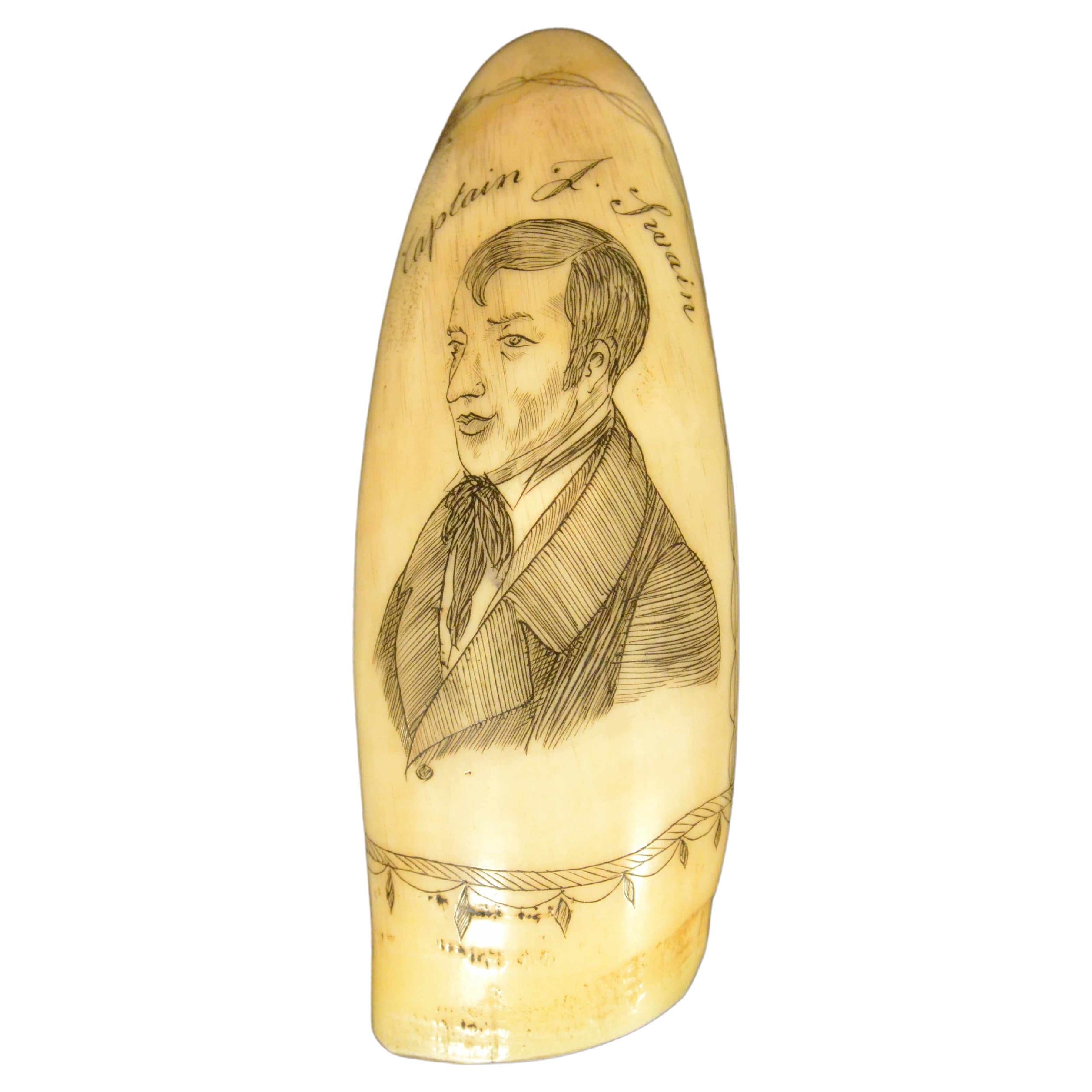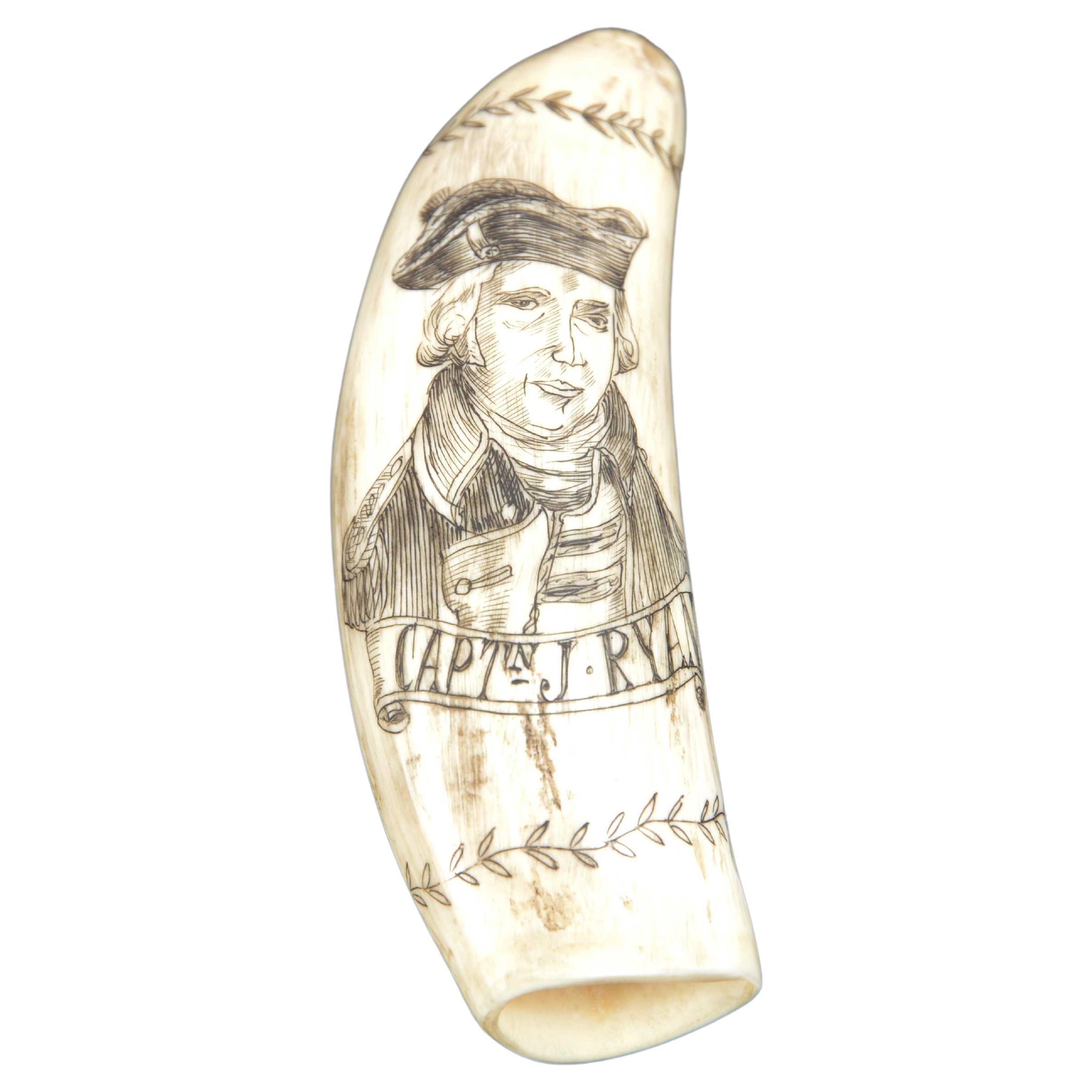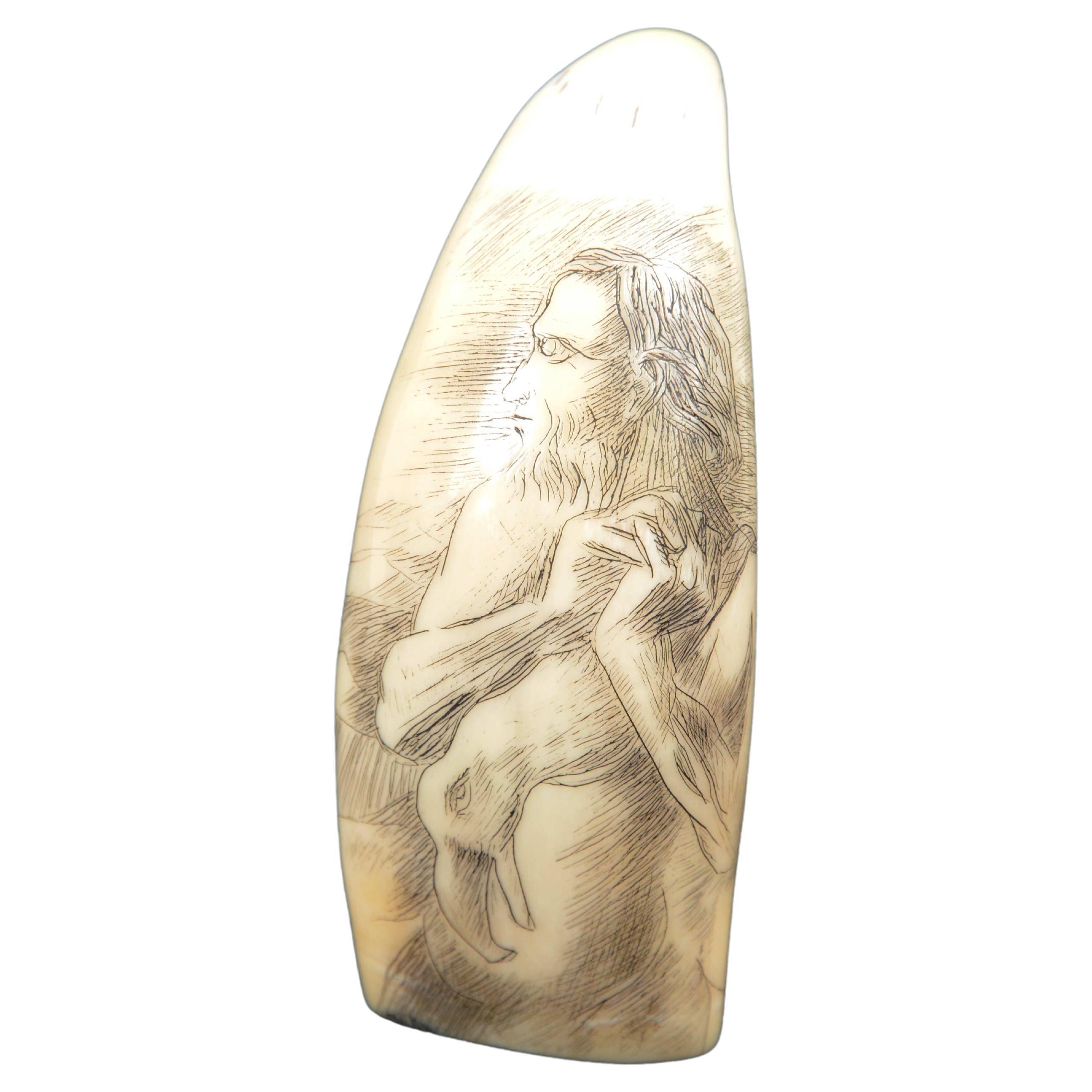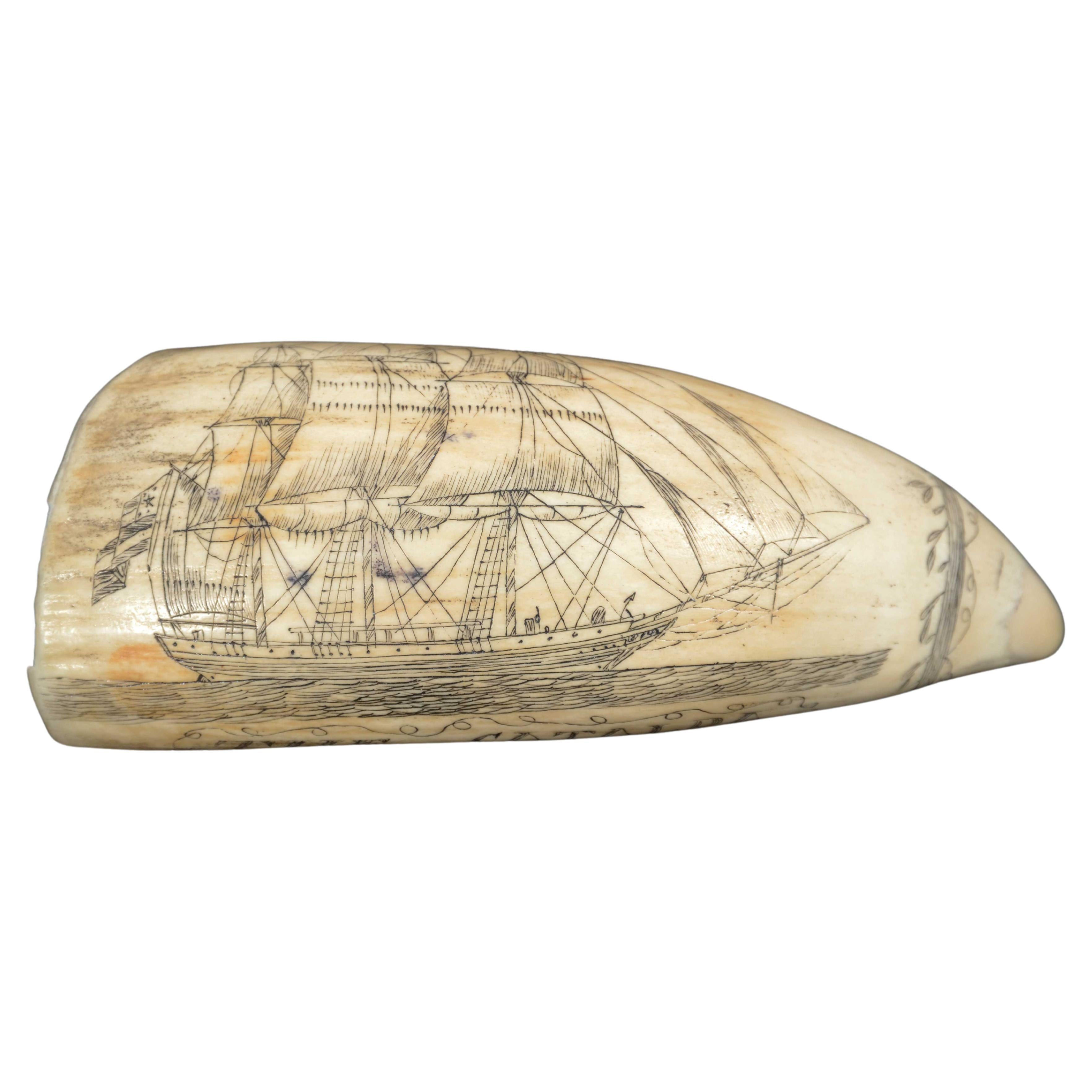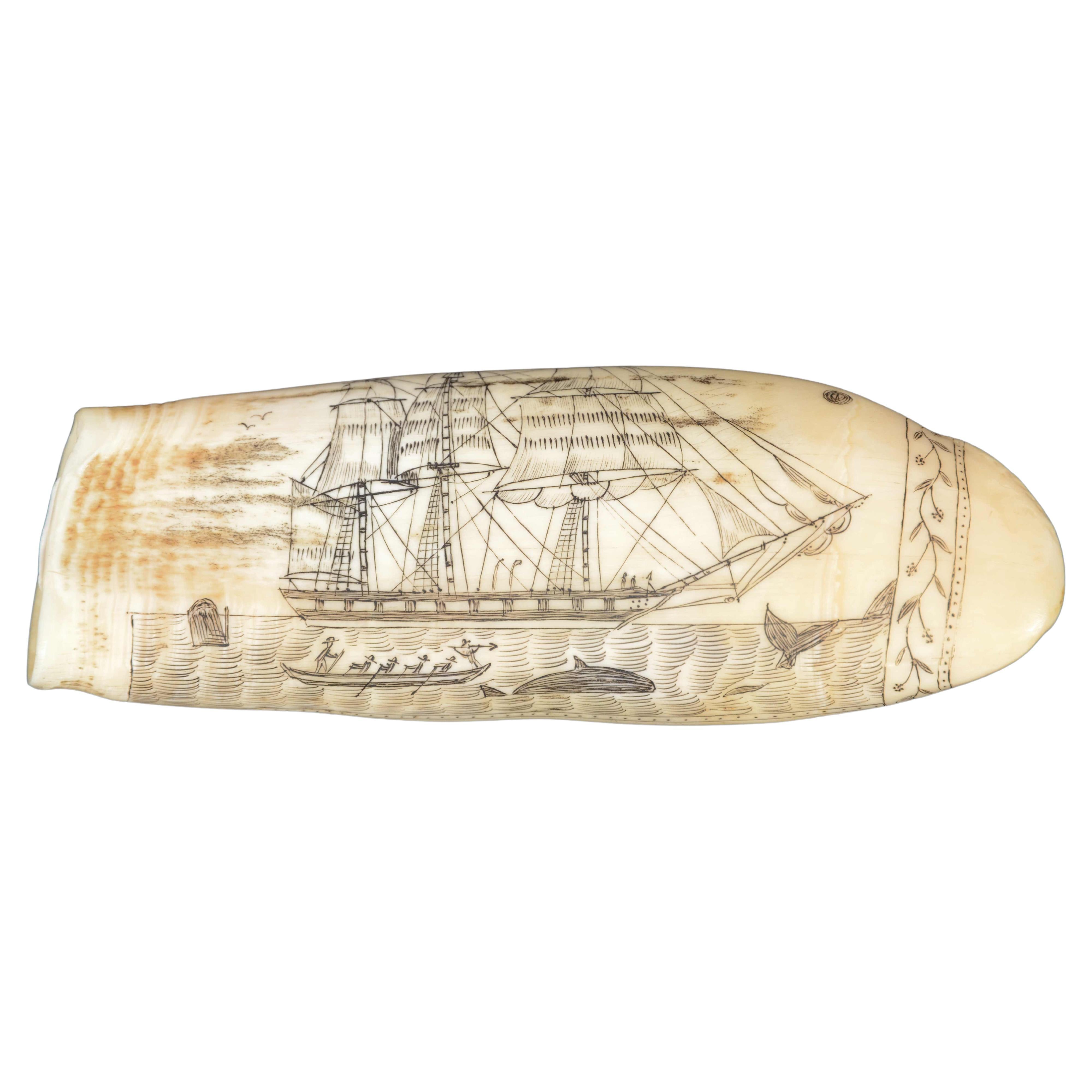Items Similar to Scrimshaw of engraved orca tooth native to the Mariana Islands semi-nude 1850s
Want more images or videos?
Request additional images or videos from the seller
1 of 16
Scrimshaw of engraved orca tooth native to the Mariana Islands semi-nude 1850s
About the Item
Scrimshaw of an engraved orca tooth depicting native of the Mariana Islands semi-nude, above the head the initials R.F. On the back bow vessel, tropical beach with palm trees and rocks and the inscription: on the MARIANA Is. The Lovely native girls washed unashamed by our glances.
Datable to around the mid-19th century.
Good condition, ancient crack on end.
Measures 11x2.7x2.5 cm - inches 4.35x1.2x1.
The last photo is the gift box.
The word "scrimshaw" refers to an art form (and the various products of this art) that developed aboard American whaling ships between 1745 and 1759 as a means of entertainment to occupy time during the long hours aboard; this art form consisted of a process of carving and engraving whale bones and teeth, with which a wide range of both everyday and ornamental objects were made, which were usually made as souvenirs for members of one's family. Nella scelta dei materiali il primo era sicuramente il dente d'avorio del capodoglio. Solo la punta del dente era liscia ed era necessario preparare il resto della superficie ruvida lucidandola. Il dente era ben immerso in acqua salata o calda, spesso con l'aggiunta di potassio. Quindi veniva utilizzata una lima per strofinare e arrotondare la superficie, e infine una carta vetrata fine per completare il processo. L'ultima fase della lucidatura veniva eseguita con pomice o cenere e poi il dente veniva strofinato ancora con il palmo della mano. Each step had to be performed very slowly so as not to affect the smooth surface of the tooth. In terms of subjects for scrimshandering, the most common were a drawing of a ship or scenes of cetacean capture, made with a needle or knife, or an appropriate blade: for example, thanks to Herman Melville we know that some whalers had boxes of dentist's tools specially designed for scrimshandering. The origin of scrimshandering, as the whalers called it, i.e., the art of making scrimshaw, is a mystery: theories range from locating its origin in Eskimo culture or with Native Americans to emphasizing the influence of South Sea islanders. La spiegazione di Edouard A. Stackpole (1903 -1993), giornalista americano, scrittore e storico di caccia alle balene, è forse la più plausibile: lo scrimshaw sarebbe stato semplicemente lo sviluppo marittimo dell'antica arte di intagliare l'avorio, così come era stata praticata per secoli, e in quanto forma d'arte popolare non sarebbe stato altro che un adattamento da parte dei balenieri americani di un antico mestiere.
- Dimensions:Height: 4.35 in (11.05 cm)Diameter: 1.2 in (3.05 cm)
- Materials and Techniques:Teeth
- Period:
- Date of Manufacture:1850
- Condition:Wear consistent with age and use.
- Seller Location:Milan, IT
- Reference Number:1stDibs: LU1020237386532
About the Seller
4.9
Platinum Seller
These expertly vetted sellers are 1stDibs' most experienced sellers and are rated highest by our customers.
Established in 1999
1stDibs seller since 2014
370 sales on 1stDibs
Typical response time: <1 hour
- ShippingRetrieving quote...Ships From: Milan, Italy
- Return PolicyA return for this item may be initiated within 14 days of delivery.
More From This SellerView All
- Scrimshaw of engraved whale tooth depicting naked woman with very 1850s faceLocated in Milan, ITScrimshaw of an engraved whale tooth, depicting naked woman with a very end, with long hair and turgid breasts flying the American flag, on the back large vessel with sails unfu...Category
Antique Mid-19th Century Nautical Objects
MaterialsTeeth
- Scrimshaw of engraved whale tooth depicting the Captain F. Swain 1850Located in Milan, ITScrimshaw of an engraved whale tooth, depicting on one side the half-bust of the smartly dressed and handsome Captain F. Swain. On the Back the inscription Master The WHALER SWAN f...Category
Antique Mid-19th Century Nautical Objects
MaterialsTeeth
- Scrimshaw of a vertically engraved orca tooth with half bust Captain RYANLocated in Milan, ITScrimshaw of a vertically engraved orca tooth , dated around the mid-19th century. Depicting the half-bust of Capt. J. RYAN, engraving of excellent execution and rich in detail, on...Category
Antique Mid-19th Century Nautical Objects
MaterialsTeeth
- 7990 Scrimshaw of vertically engraved whale tooth dated around 1850Located in Milan, ITScrimshaw of a vertically engraved whale tooth datable to around the mid-19th century depicting an old sailor with a beard and long hair holding leaning over one shoulder a cormoran...Category
Antique 1850s Nautical Objects
MaterialsTeeth
- Scrimshaw of excellently made engraved whale's tooth dated around 1850Located in Milan, ITScrimshaw of an engraved and beautifully crafted whale tooth dated around the mid-19th century depicting vessel with full sails under sail, on the back a lady in a long dress with in...Category
Antique Mid-19th Century Nautical Objects
MaterialsTeeth
- Engraved whale tooth scrimshaw of fine workmanship datable around 1850Located in Milan, ITScrimshaw of an engraved whale tooth, fine workmanship datable to around mid-19th century, length 11.7 cm, depicting whaler with men aboard, boat rowing with 6 whalers one of them i...Category
Antique 1850s Nautical Objects
MaterialsTeeth
You May Also Like
- Antique Engraving of Tinian, an Island of the Northern Mariana Islands, 1757Located in Langweer, NLAntique print titled 'Vue de la Rde de Tinian Gezigt van de Rheede van Tinian (..)'. Views of the south-west side of the island of Tinian and a view of the anchorage of Tinian, w...Category
Antique 1750s Prints
MaterialsPaper
- Antique Print with Views of Tinian Island, the Northern Mariana Islands, 1749Located in Langweer, NLAntique print titled 'Le cote du sud-ouest de l'Ile de Tinian' and 'Vue de la rade de Tinian, ou le Centurion fit de l'eau.' Views of the south-west side of the island of Tinian and a view of the anchorage of Tinian, where the Centurion got water. This print originates from 'Reize rondsom de Werreld (..)' by George Anson, published 1749. Tinian is one of the three principal islands of the Commonwealth of the Northern Mariana Islands...Category
Antique 18th Century Prints
MaterialsPaper
- Spanish, 1850s Fair Carousel Wooden DogLocated in Marbella, ESSpanish, vintage hand painted wooden dog with stuck out tongue, from an old fair ground Carousel.Category
Antique Mid-19th Century Spanish Mid-Century Modern Animal Sculptures
MaterialsWood
- Antique Engraved Map of the Friendly Islands or Tonga, ca.1785Located in Langweer, NLAntique map titled 'Carte des Isles des Amis'. Map of the Friendly Islands / Tonga. The Tongan people first encountered Europeans in 1616 when the Dutch vessel Eendracht, captain...Category
Antique 1780s Maps
MaterialsPaper
- Samuel Johnson — A Journey to the Western Islands of ScotlandLocated in Middletown, NYLondon: W. Strahan and T. Cadwell, 1775. FIRST EDITION, FIRST STATE 8vo, 8 3/8 x 5 1/4 (212 x 132 mm); Title, 284 pp, 1 leaf (errata with 11 items on 12 lines). Printed on laid pap...Category
Antique Late 18th Century English Books
MaterialsLeather, Paper
- Antique Map of the British Islands to the White Sea by J. ImrayLocated in Langweer, NLAntique large nautical chart of the British Islands to the White Sea. With insets of Veshnyak Channel, Sosnovets and the Bay of Arkhangel. Published by James Irmay and Son, circa 1875.Category
Antique Late 19th Century Maps
MaterialsPaper
Recently Viewed
View AllMore Ways To Browse
Ship Compass Hand Held
Used Nautical Objects
Nautical Collectables
Glass Lens Nautical
Vintage Nautical Instruments
Vintage Porthole Window
Nautical Compass Antique Wood
Vintage Nautical Bell
Vintage Navigation Instruments
Boat Steering Wheel
Vintage Pond Yacht
Gimbal Compass
Brass Ships Wheel On Pedestal
Nautical Propeller Vintage
Vintage Cabin Cruiser
Vintage Nautical Pulley
Vintage Nautical Pulleys
Antique Boat Compass

